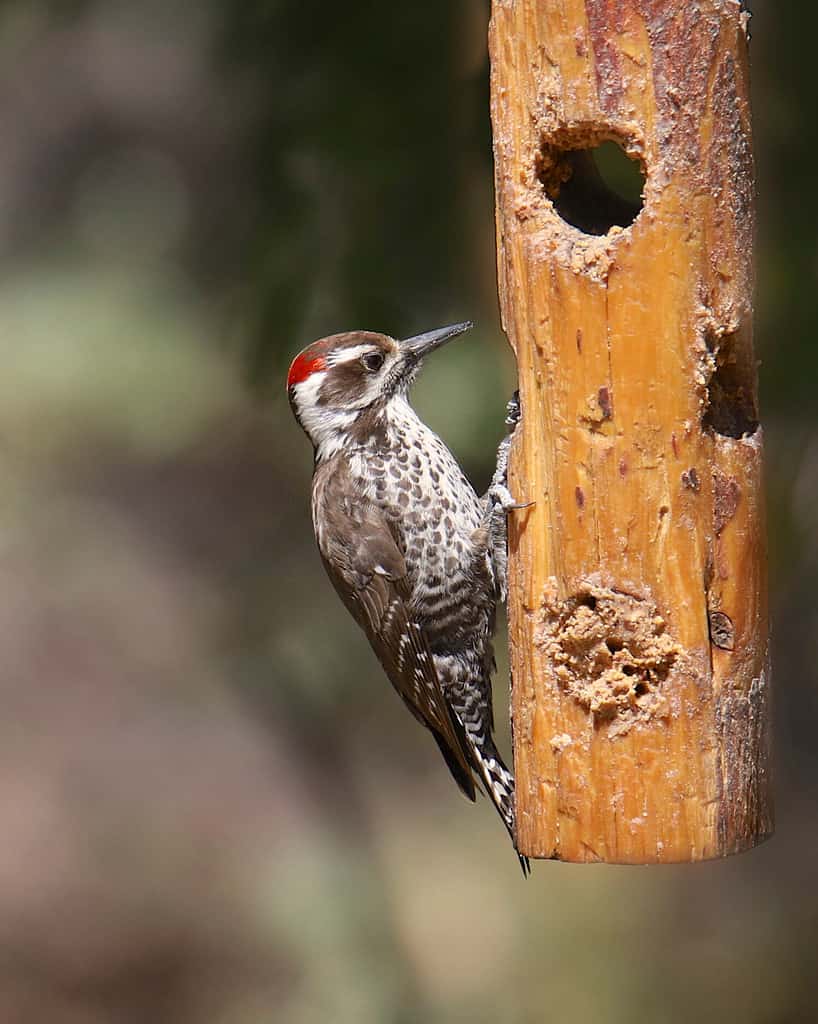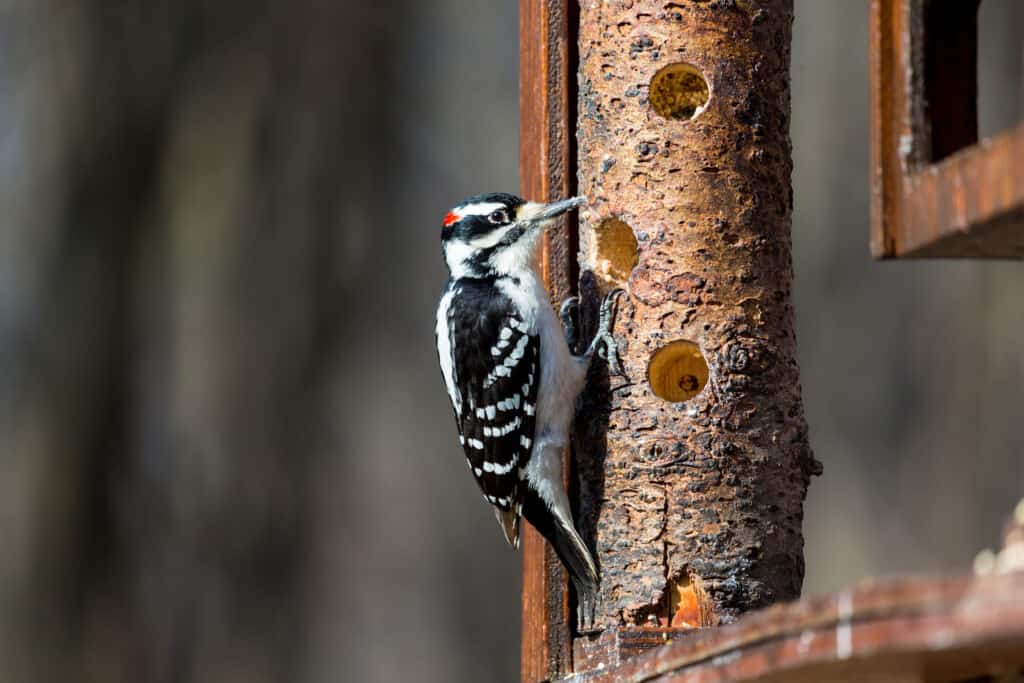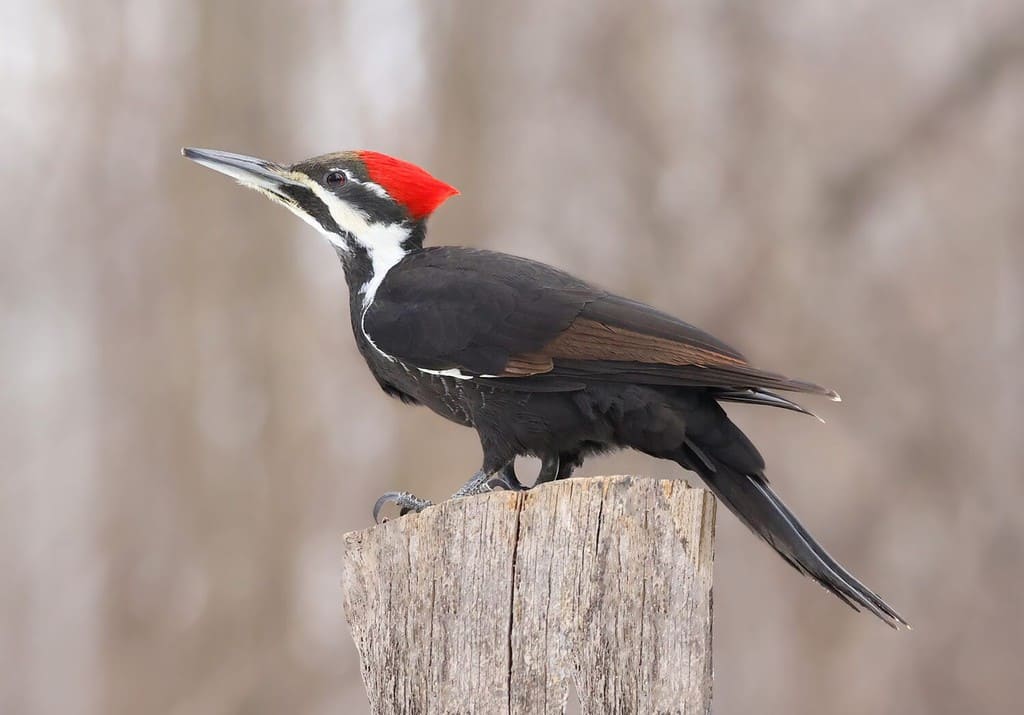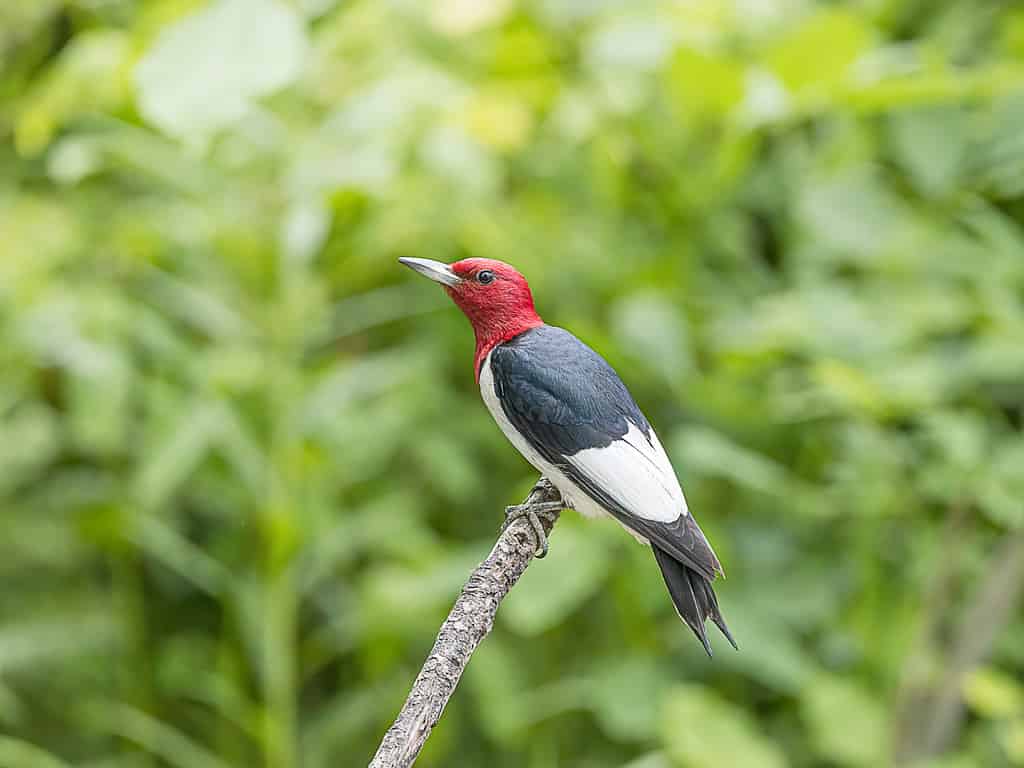Uniquely beautiful and equally intriguing, woodpeckers in Maryland offer something other bird species simply don’t. And whether you love their hammering sounds in ethereal forests or just love seeing their vivid crowns and bold black and white coloration, they are intriguing to watch.
In Maryland, you could spot up to 8 woodpecker species in nearly any region of the state. Look for them at your backyard feeders, in deciduous forests, in parks, in orchards, and other woodlands.
Let’s see which woodpecker species you might spot on your birding adventures in Maryland.
How to Attract Woodpeckers to Your Backyard

Want to bring woodpeckers into your yard in Maryland? Try suet feeders, peanut butter, peanuts, and black sunflower seeds.
©vagabond54/Shutterstock.com
For those eager to see these beautiful woodpeckers in Maryland, a few tricks can help draw them to your backyard.
- Provide proper woodpecker food. Offer both suet and black sunflower seeds. These help draw them in but also help provide them food when natural sources are scarce nearby.
- Leave dead trees and stumps as they are. They love drilling on these for insects and other goodies.
- Add a water feature, like a stream or birdbath. They need water to drink and do enjoy a good splash around at times.
- Plant native plants with fruits and nuts. Woodpeckers love these native fruiting plants for their meal sources.
- Provide nesting boxes. Many species frequent these each breeding season.
Where to Look for Woodpeckers in Maryland
You’ll find woodpeckers in numerous areas of Maryland. From the deciduous forests to the backyard feeders, these birds live all over the state. Many frequent suburban and urban areas, heavily relying on the food offered in suet and seed feeders.
In the wild, some of the best places to spot these incredible birds include:
- Assateague Island National Seashore
- Blackwater National Wildlife Refuge
- Patapsco Valley State Park
- Catoctin Mountain Park
Red-bellied Woodpecker

Red-bellied woodpeckers make their nest in a hole they make in a dead or decaying tree. You’ll find them in many places in Maryland, particularly backyards with peanuts!
©FloridaStock/Shutterstock.com
- Scientific name: Melanerpes carolinus
- Order: Piciformes
- Family: Picidae
- Size: 9.4 inches
- Loves: suet, peanuts, peanut butter
Fans of peanuts and peanut butter feeders, you’ll draw in the red-bellied woodpecker with moderate ease. These beautiful birds love backyard feeders and make their nests in woodlands and forests.
This particular species of woodpecker makes itself known by drumming only during mating season, though. So, instead of listening for them, keep an eye out for red bellies, red crowns, and bar-coated feathers. Their fronts and faces are brown in most cases, as well, helping make them moderately easy to identify. The medium birds are noisy, love to peck at house siding, and often damage cedar shingles.
They build their nests in dead trees and lay between 4 and 5 eggs. They feed on spiders, fruit, nuts, insects, and seeds and significantly impact the dispersal of oak and beech seeds.
Yellow-bellied Sapsucker

Yellow-belly sapsuckers are omnivores, and like their namesake, sapsuckers eat, live and breathe sap. You’ll find these beauties in Maryland.
©Glass and Nature/Shutterstock.com
- Scientific name: Sphyrapicus varius
- Order: Piciformes
- Family: Picidae
- Size: 7.1 to 8.7 inches
- Loves: tree sap and suet
A gorgeous bird whose name implies some other species, the yellow-bellied sapsucker is, indeed, a woodpecker in Maryland. The species frequently nests in young deciduous forests, particularly where maples and birch are present. Occasionally, they may be found in mountains or plains.
As their name also indicates, they feed on nectar and sap from these trees. If you want them to visit your backyard, provide them with suet feeders.
Usually building nests as high up as possible, yellow-bellied sapsuckers bear reddish crowns and throats. They have black and white bars and flecks on their wings, tails, and bodies. Larger than downy woodpeckers, but smaller than hairy woodpeckers, these beauties also have straight bills and long wings.
One interesting thing about these birds is that they are known for the largest migratory pattern of any woodpecker in the world. They fly as far north as Arkansas for breeding and as far south as the Caribbean or Panama.
Hairy Woodpecker

Hairy woodpeckers love to visit trees where they’ll find loads of insects. They drill holes looking for them anywhere they sense the bugs crawling around.
©Glass and Nature/Shutterstock.com
- Scientific name: Leuconotopicus villosus
- Order: Piciformes
- Family: Picidae
- Size: 7.1 to 10.2 inches
- Loves: trees full of insects
The hairy woodpecker loves making its home in woodlots, parks, cemeteries, and backyards. In these locations, they have plenty of food to find, especially when the trees offer deadwood to their favorite meal: insects! They like conifers for their homes, especially, and may be found just about anywhere in the United States.
The adorable birds earned their common name of “hairy woodpecker” because of the fluffy, hairy appearance their feathers give them. They’re small, frequently drill loudly, and revel in sap and insects in holes any critter has drilled.
Long pointed bills adorn these birds’ faces, with white feathers, a white chest, and speckled wings. They are smaller than their cousin, which folks often confuse them for (downy woodpeckers) and have longer bills.
Each year, these birds build their nests in breeding season and lay between 3 and 6 eggs per brood.
Northern Flicker

Both male and female norther flickers show off bright coloration. They’re just one of the exciting species of woodpeckers in Maryland you might spot this year.
©iStock.com/Irving A Gaffney
- Scientific name: Colaptes auratus
- Order: Piciformes
- Family: Picidae
- Size: 11.0 to 12.2 inches
- Loves: ground insects, especially ants
Though the name doesn’t imply woodpecker, northern flickers are, indeed, of the woodpecker family. If you ever observe one, you’ll immediately notice its physical resemblance to other woodpeckers, apart from coloration. The birds have been called other names as well, including the yellow flicker or red-shafted flicker.
These birds prefer open woods, forest edges, suburban areas, and parks where they can forage for food on the ground. These common woodpeckers in Maryland are among some of the largest of the family in the United States. Northern flickers drum along on the ground, though, instead of on trees, another reason folks may not think of them as woodpeckers.
The coloration varies somewhat, but they mostly have flecked tails and wings with black markings on their faces. They bear black crests, with yellow to red colored faces and wings, and brown shades on their bodies.
Northern flickers have a wide range of calls which may be heard, though most describe them as having musical tone than notes. They also make gurling calls and cries that sound like “wicka-wicka-wicka.”
Pileated Woodpecker

The Pileated Woodpecker loves to dine on carpenter ants. If you want to see these beauties visit your backyard, provide them with loads of dead stumps where ants build.
©Vlad G/Shutterstock.com
- Scientific name: Dryocopus pileatus
- Order: Piciformes
- Family: Picidae
- Size: 15.8 to 19.3 inches
- Loves: carpenter ants
One of the largest woodpeckers in the world, the pileated woodpecker thrives in the mature forests of Maryland. They also love drowned forests with dead trees and, delightfully, backyard suet bird feeders. The large bird stands at up to 19.3 inches in height, displaying a vivid red crown and a black and white body. Their long legs, thin beaks, and markings help to make them identifiable for many. Males also have facial markings that look a bit like a mustache. Some folks confuse the pileated woodpecker with the once thought extinct ivory-billed woodpecker.
These big, beautiful birds leave behind large, rectangular holes as they hammer away at trees looking for insects. They dine on ants while giving out loud, high-pitched piping calls. They generally hang out in the eastern United States, but they’ve been seen as far north as Nova Scotia and, on rare occasions, as far west as California.
Red-cockaded Woodpecker

The Red-cockaded Woodpecker is the rarest in the country. But you might occasionally spot one in Maryland anyway!
©feathercollector/ via Getty Images
- Scientific name: Dryobates borealis
- Order: Piciformes
- Family: Picidae
- Size: 7.9 to 9.1 inches
- Loves: fruits, seeds, and insects
Most commonly spotted in western and central Maryland, the Red-cockaded woodpecker rarely shows its head. They love living in pine woods where they burrow soft wood holes to create their nests. These beauties come in much smaller than others on the list, coming in at about the size of a robin. Their fuzzy looking feathers come in brown bars on their wings and tails. Their heads have black and white markings, with the males adorned with tiny red chest markings.
They live in family units that remain together for about one year after the chicks are born. After this, males fly off to start their own families.
Unfortunately, these incredible woodpeckers have been considered endangered since 1970. Only about 15,000 of them still exist.
Red-headed Woodpecker

The red-headed woodpecker is just one of eight species of woodpeckers in Maryland.
©ilkah/Shutterstock.com
- Scientific name: Melanerpes erythrocephalus
- Order: Piciformes
- Family: Picidae
- Size: 7.5 to 9.1 inches
- Loves: insects, fruits, seeds, suet, small birds
A large species of woodpecker in Maryland, the red-headed woodpecker may often be heard drumming away in the distance. They don’t usually call often, but their drumming is one of the most distinctive sounds you’ll hear among the trees. Look for these beauties in woodlots, dead timber swamps, pine savannas, and farms. You’ll occasionally spot them on backyard feeders, too.
The brightly colored woodpeckers may catch insects by hammering at trees or may even snatch smaller birds from the air.
You’ll identify these large woodpeckers by their namesake: bright red crowns on bright red heads. White bodies and monochrome wings and tails accompany the red heads.
Males of the species choose the nesting sites and help their partners build the nests. Each year, two broods may be born, with three to ten eggs each. Just 12 to 14 days later, the eggs will hatch, and then another 24 to 31 days later, the fledglings leave the nest. Red-headed woodpeckers in Maryland can be aggressive, too, attacking larger birds like ducks, when seeking out their nesting grounds.
Downy Woodpecker

The beautiful downy woodpecker loves to nosh insects, fruits, weeds, and seeds in Maryland yards.
©J Edwards Photography/Shutterstock.com
- Scientific name: Dryobates pubescens
- Order: Piciformes
- Family: Picidae
- Size: 5.5 to 6.7 inches
- Loves: tree sap and insects, fruits, weeds, seeds
The smallest native woodpecker in the United States, the downy woodpecker, shows off its adorable, fluffy feathers, earning its name. The beautiful bird emits bright, sharp calls and frequently visits backyard feeders.
Downy woodpeckers have large black and white spots, with males bearing red dots on their heads. Stripes and spots cover their wings, creating a snowflake effect. Each downy woodpecker is a little bit different from the next! They bear mostly black wings with those dots, and white bellies to coordinate.
These woodpeckers nest in dead trees and dead portions of trees, drilling to create cavities for their nests. They line the nests with wood chips for their single brood each year. Each clutch may contain three to eight eggs. Typically, you’ll find downy woodpeckers in open woodlands, parks, orchards, and backyards. They love hanging out with other small birds like chickadees and enjoy chilling in the tall weeds.
The photo featured at the top of this post is © iStock.com/Flatcoater
Thank you for reading! Have some feedback for us? Contact the AZ Animals editorial team.







